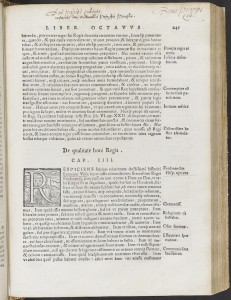A look at the lightly annotated books
I’m Amanda Brunton, one of the research assistants working on Harvey’s marginalia as part of the Archaeology of Reading project. I joined the team at the beginning of March and will be contributing to this blog as I transcribe the marginalia. The rest of the group have been very kind in letting me get started on some of the more lightly annotated books, so while the pages that Jaap and Chris have written about below are quite densely annotated, the books that I have been working on look more like this:

Although less heavily written on, texts such as these can still provide a useful insight into the practice of annotation and the way in which Harvey used his books in conjunction with one another. I have recently finished the first draft of transcriptions of Harvey’s annotations in Historia de Gentibus Septentrionalibus, by Olaus Magnus. The Historia details the history, customs, and way of life in the Nordic countries, (complete with beautiful illustrations) and has been quite lightly annotated.
Some books seem to be lightly annotated because Harvey was primarily interested in specific sections—for example, entire chapters of his copy of Melanchthon’s Selectarum are untouched, while others contain a flurry of heavy underlining in both pen and chalk. This is not the case for the Historia, which contains small marks almost throughout—for example, underlining or little “plus signs”—yet only 33 of almost 600 pages contain written annotation.

So many plus marks!
This is particularly surprising because the Historia seems to have made a real impression on Harvey, informing his reading of other books in his library. For example, Harvey’s marginal notes in his copy of Machiavelli’s Art of War contains two separate references to the Historia in which Machiavelli’s strategies are compared to those described in book eight of the Historia.
Though these lightly annotated books do not contain as much discursive material as their more heavily annotated counterparts, they are still able to provide insights into the processes of reading and annotating. The Historia demonstrates that light annotation does not always indicate a lack of close reading on Harvey’s part, and that more lightly annotated books are still held in consideration when reading other books in the library. While the practice of annotation can sometimes be considered a two-way dialogue between heavily annotated texts, in this case, the Historia is a reference point in a one-way transfer of information.
This isn’t to say I’m not looking forward to transcribing some of the more challenging books, but the opportunity to work on the lightly annotated books has provided me a great insight into how these texts were read and used.
